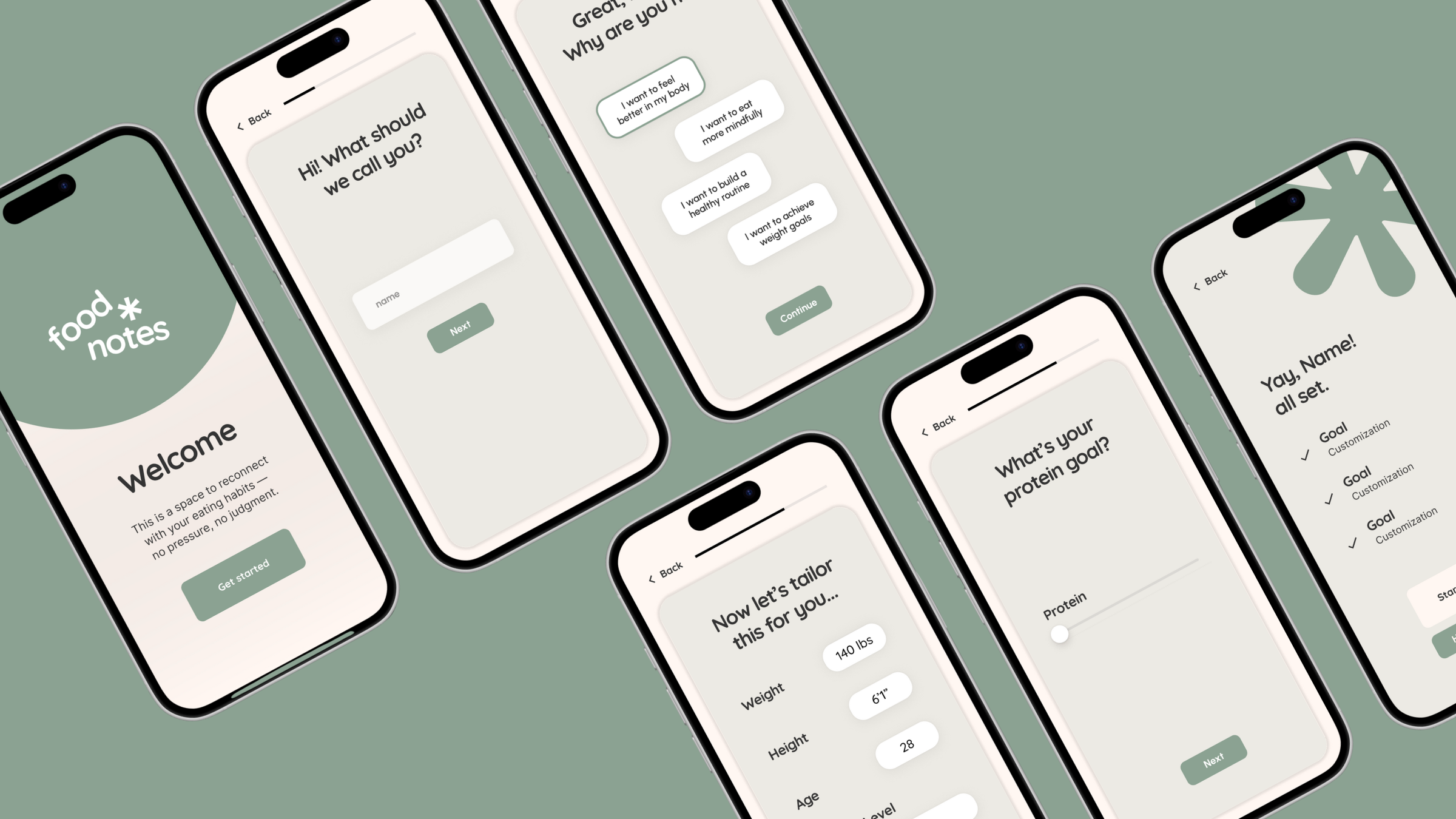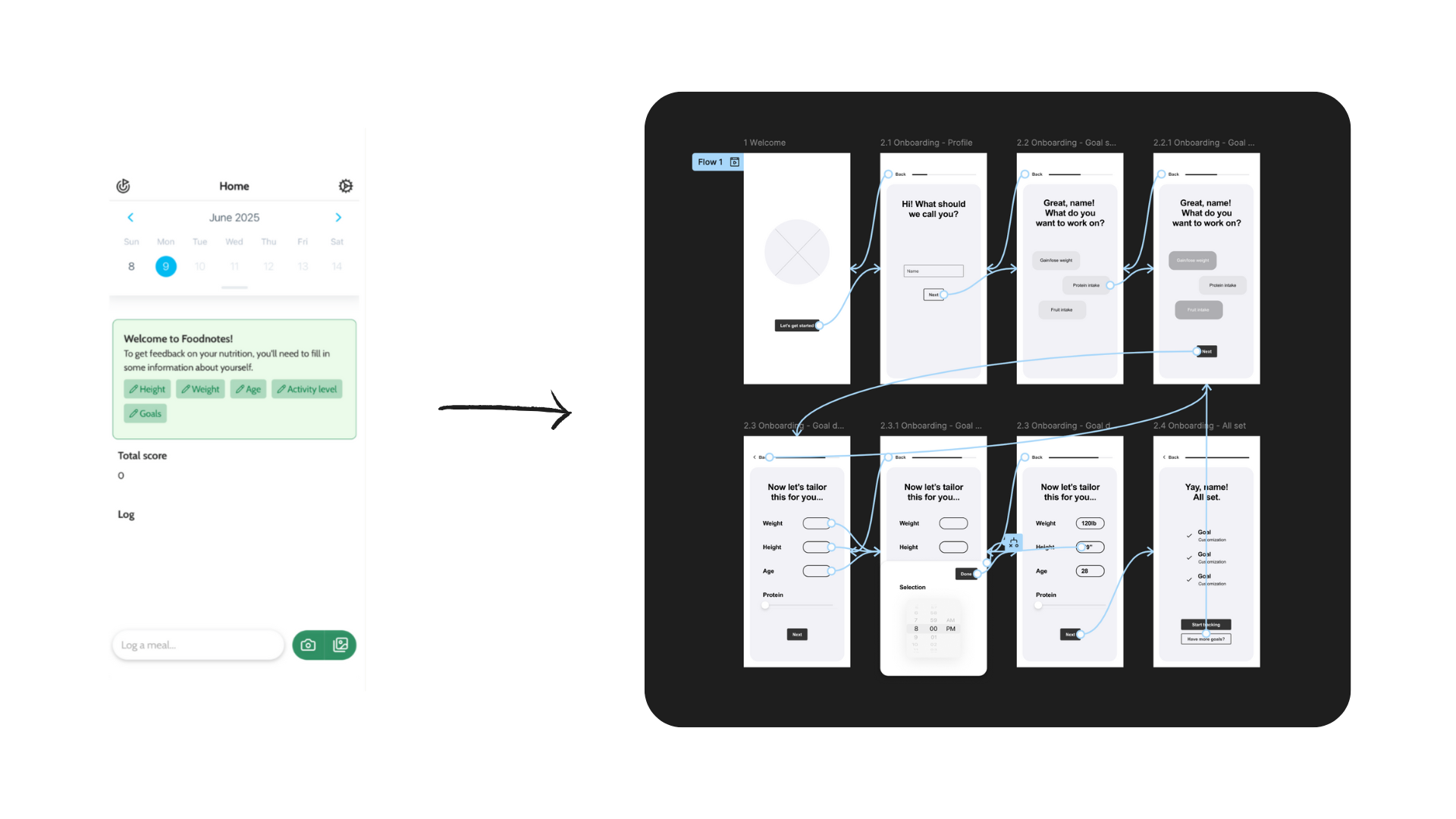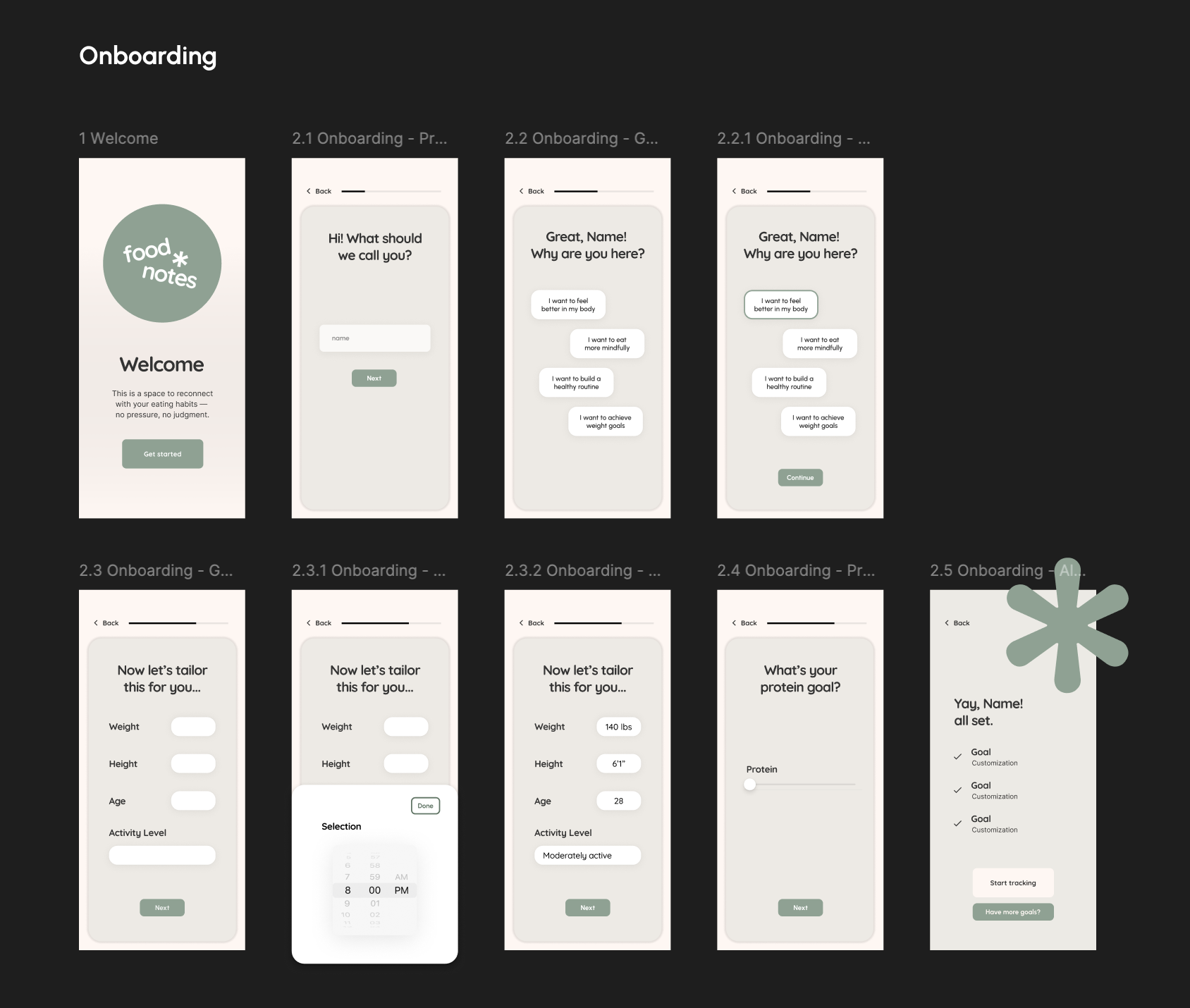
C A S E S T U D YProduct design
Project
Foodnotes: Redefining nutrition with empathy-driven UX
Role
Lead UX/UI Designer
Challenge
A strong backend was in place, but the project lacked clarity on how users would interact with the product. Feature priorities were unclear, and onboarding was clunky. I stepped in, applying a UX lens to define the user problem, structure the design, and drive the product forward with purpose.
Skills: User Research • Wireframing • Prototyping • Interface & Interaction Designracdesig
Shifting assumptions
Our early assumption was that users just found food logging inconvenient, but we weren’t sure if that was the real hindrance. I conducted 6 in-depth user interviews (including one edge case) to explore users’ daily routines, emotional triggers, and past app experiences.
Empathy mapping revealed a consistent pain point: traditional calorie tracking caused stress, guilt, and burnout. Despite varied discipline, all expressed a desire for a more compassionate approach that leaned into progress, not perfection.
T H E R E S E A R C HKey findings
Calorie targets induced anxiety for high-performers
Guilt from “slip-ups” discouraged long-term use
Users wanted flexible feedback that adapts to their lives
Everyone desired an app that moved them away from daily tracking, not deeper into it
This shifted our product assumptions. It became about restoring trust in one’s own choices, not just simplifying food entry. It reframed the product around emotional wellness beyond mere functionality.
T H E U S E R S
Who is this for?
Based on the interviews, I developed 4 user personas grounded in emotional and behavioral needs. These personas began to guide design and prioritization decisions.
Louis, 35
Health-conscious young dad
Wants to be healthy for his family, but time is tight. Self-motivated, but needs data-driven summaries and flexible nudges that don’t interrupt his flow.
Tessa, 33
High-discipline fitness enthusiast
Disciplined and performance-driven. Used to strict macro tracking, but emotionally exhausted. Wants to reduce reliance on data without losing control.
Mike, 45
Low-motivation with health concerns
Avoids “work-like” apps. Needs gentle, simple prompts and non-judgmental feedback to stay engaged.
Linda, 60
Rebuilding confidence after setbacks
Post-accident, rebuilding confidence. Emotionally sensitive to past weight struggles. Needs soft reinforcement, small wins, and zero guilt.
W I R E F R A M I N G
Early concepts
The app was functional with a strong backend, but opened straight to the homepage.
User research highlighted a critical gap: the absence of a gentle onboarding compromised the desired emotional experience. This led to wireframing early concepts focused on a soft, empathetic onboarding flow.
U S E R T E S T I N GDoes this resonate?
To validate our human-first approach, I ran concept validation sessions with users across our persona types. We gathered feedback on early ideas for non-stats-based inputs, emotionally supportive feedback, and soft onboarding flows. The discoveries made validated our assumptions and guided our refinements.
-
Users responded positively to the absence of traditional calorie tracking. Participants noted:
“I really appreciate that it doesn't show me calories. It makes me feel less stressed about food and more focused on just making good choices.”
“The progress updates felt encouraging, not like a report card. It's so different from other apps that just make you feel guilty about numbers.”
This validated our hypothesis: users prefer a flexible, non-punitive experience. It reinforced our commitment to descriptive summaries over raw numerical data in design.
-
Emotional and qualitative feedback was well-received, fostering a sense of compassion. Users expressed:
“Seeing feedback about how I'm feeling and my overall habits, rather than just just grams or calories, is a huge relief. It feels more human.”
“This app actually helps me build confidence around my eating habits, which is what I really need. The small wins really resonate.”
This highlighted the importance of empathetic language and progress-over-perfection messaging. We further integrated supportive affirmations and celebratory moments throughout the user journey.
-
Participants valued the app's gentle introduction and straightforward interactions, contrasting it with overwhelming experiences.
“Starting with this app felt very gentle. I wasn't overwhelmed by tons of questions or complicated setups right away, which is great for someone like me who avoids complex apps.”
“It's so easy to check in without feeling like I'm doing 'work.' I can see myself actually sticking with this.”
This confirmed our soft onboarding flows' effectiveness. It guided our efforts to maintain a minimalist UI and intuitive navigation.
M O C K U P S & P R O T O T Y P E S
What can this look like?
As a result, the team's focus shifted to refining the onboarding experience. Building on the PM and engineering's polished wireframes for implementation, I evolved these into hi-fi mockups and interactive prototypes.
While development concentrated on onboarding, I took the initiative to dive into research insights and created a supplementary onboarding UX flow and brand style guide to set the team up for success when they were ready to expand.
These guidelines offered a clear direction for how flexible habit input and encouraging, visually-driven progress feedback could be integrated, ensuring the app's consistent ethos.
Onboarding UX Flow
App philosophy • Intention setting • Text previews • Streak support nudges • Empty state UX copy
Brand Style Guide
Mission: Empower users to build sustainable eating habits through intuitive, non-punitive nutrition tracking.
Tone: Supportive, calm, and quietly optimistic. Avoid clinical, gamified, or judgmental language.
Target Audience: Adults aged 25–45 navigating life transitions (e.g., parenthood, health shifts) seeking food autonomy.
R E F L E C T I O NHandoff & Takeaway
I provided a solid, human-first UX foundation, including:
Key user flows: Visuals for a new onboarding flow backed by user research
Foundational UX copy: Guidance for emotionally resonant language around critical paths like habit logging and progress feedback
Brand style guide: A visual and interaction roadmap to guide and maintain brand presence
Naturally, I would have loved to see through the complete development of all flows. This project, however, was an invaluable opportunity to lend my skills in bringing UX clarity and propelling teams forward, even from a mid-point start.
Impact
User insights unlocked a new direction for the product; one that treats emotional wellness as central to nutrition design. My work helped:
Unblock decision-making by grounding features in empathy
Shift team focus from calorie entry to habit formation
Deliver a flexible, emotionally resonant product experience



